 . . . . . . . . . . . . |
Serving the
Portuguese-American
community since 1979 |
| 1 de Maio de 2001 . . . . . . ENGLISH SECTION |
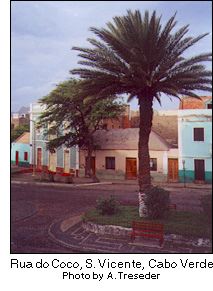 CABO VERDE: A JOURNEY
CABO VERDE: A JOURNEY

By Anne Treseder

Last November, after years of listening to its music, I journeyed to Cabo Verde, the island nation off the west coast of Africa. Cabo Verde is the place where Portugal and Africa first met to form a unique people and culture. A Portuguese colony until 1975, Cabo Verde has a total population of approximately 400,000 people, living on nine inhabited islands.
I traveled to two of those islands, Sal and São Vicente. I wanted to hear Caboverdian "mornas," the songs of "sodade" (saudade) that have been compared to fados, in the land of their birth. I traveled alone, but with lots of useful pre-trip coaching from Caboverdian friends here in California.
I flew from San Francisco to New York City (NYC) to connect with the South African Airways flight from NYC to Johannesburg, which makes a stop on the island of Sal each Tuesday. The eight-hour flight from NYC to Sal passed quickly -- most of the passengers were Caboverdian, and the whole plane was alive with dozens of conversations in Portuguese and Caboverdian Crioulo. I tried to practice my limited Portuguese and Crioulo, and I made friends with several Caboverdians who were returning home from New England.
We arrived in Sal at 4:30 a.m. on Wednesday morning. Descending from the plane to the tarmac, I felt the warm Caboverdian air. Going through immigration was confusing at first, but I was rescued by Mrs. Soares, a Caboverdian woman whom I had met as I was boarding the plane to Sal. She helped me through immigration and customs, and left me in the care of her nephew, who worked at the airport. He put me into a taxi to the village of Santa Maria, on the south coast of Sal, where the Hotel Morabeza is located.
And so, an hour before dawn, I found myself riding south on the one-lane road to Santa Maria, in absolute darkness except for our car lights, which shone on empty, mustard-colored sand stretching to the Atlantic Ocean on either side. The taxi driver was young; his radio was playing a hip-hop tune in English -- something about "Spanish Harlem." Eventually, we saw the string of lights from Santa Maria and the beach hotels that surround it.
My room at the Hotel Morabeza was clean and uncluttered, with a bed about nine inches off the floor, and a big, tropical fan overhead. It had all the amenities, including a television, small refrigerator, and a large bathroom with a shower. It also had a private terrace with table and chairs. The air was warm, but when I lay down on the bed, I was cool, and I understood why the bed was so low to the ground. I fell asleep just as the sun rose.
When I awoke later that day, I walked to Santa Maria. I found a store where I could buy juice and chips, and bought Caboverdian CDs at the "Tropical Dance" shop. The village streets were lined with the rectangular, one-storied buildings typical of Cabo Verde. Cabo Verde is not a rich country in the monetary sense. But when I noticed a large sign that read "Bem-Vindo, Xanana Gusmão! Viva Timor Lorosae!" (the Timorese leader had recently visited Cabo Verde), I was reminded that Cabo Verde is rich in matters of the spirit.
At dinnertime, back at the hotel, I entered the patio dining area, which was decorated with colored lights and a huge buffet, and I was stabbed with the sound of a Caboverdian violin, playing "Nos Morna" (Our Morna). It came from "Ovi Creol," a musical group from Santa Maria.
Most of the guests seemed lost in conversation; Ovi Creol was background music. But I was utterly entranced. This was the music I had come to hear! It was achingly beautiful. 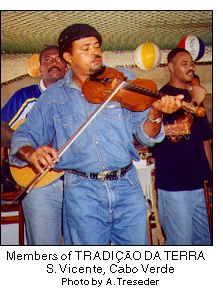 I found some cachupa (the Caboverdian national dish) among the exotic salads and spent the evening listening to Ovi Creol, applauding gratefully after every song. I found some cachupa (the Caboverdian national dish) among the exotic salads and spent the evening listening to Ovi Creol, applauding gratefully after every song.
On Thanksgiving Day, I took a taxi back to the Sal airport. The propeller-driven TACV (Cabo Verde national airline) airplane got me to the island of São Vicente in forty minutes.
· · ·
The São Vicente airport is set in a valley without trees, surrounded by bare, purple mountains. I have never been to Mars, or the outback of Australia, but the island of São Vicente resembles my mental pictures of those places. It has a desolate beauty that grows on you, that you find yourself missing after you leave.
I got a taxi to Mindelo -- to Chez Loutcha, the hotel that a Caboverdian friend had recommended. Mindelo is a city of about 50,000 people -- the biggest Caboverdian city outside the main island of Santiago. Its streets and sidewalks are made of jagged cobblestone, requiring thick soles and good tires. Many of the people, in fact, wear rubber-soled sandals.
My room at Chez Loutcha looked onto the Rua do Coco praça, which was lined with square, pastel-colored buildings on either side. I had a television, private bath with hot and cold shower, and refrigerator. At Chez Loutcha's restaurant, there were African woodcarvings and an old cimboa on the wall, and bouncy African music on the loudspeaker. The staff was full of warm smiles.
When I awoke the next morning at dawn, I opened the curtains, and looked down to see that the praça was already bustling -- with people walking to work, with school children in their uniforms, and with buses letting off passengers. The rising sun lit up the pastel buildings, and the whole praça shone brilliantly.
I proceeded to explore Mindelo on foot. I found a big indoor produce market, where I could buy fresh oranges; the Café Portugal on Rua de Lisboa, where I could buy coffee, sandwiches, and Caboverdian newspapers; and Le Café Musique (also on the Rua de Lisboa), where there is live music in the evenings. The weather was warm, but not oppressive; a gentle ocean breeze frequently cooled the air.
I walked along the waterfront, past a replica of the Tower of Belem, and found the Caboverdian Cultural Center. It has an Internet café, a great bookstore and music store, and bulletin boards announcing the latest events. The TACV office and the Portuguese cultural center are around the corner. I climbed up the Rua de Lisboa to the beautiful pink Governor's Palace, now a public building.
After more climbing, I found the Restaurant Sodade (on the roof of the Hotel Sodade), with a gorgeous view of the whole city. 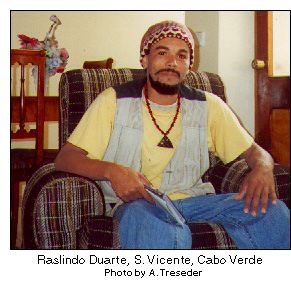 In all my wanderings in Mindelo, I never saw a traffic light or even a stop sign. Pedestrians and drivers seem to be able to co-exist without them. Taxis were plentiful. In all my wanderings in Mindelo, I never saw a traffic light or even a stop sign. Pedestrians and drivers seem to be able to co-exist without them. Taxis were plentiful.
My walks also led me to the Centro Nacional de Artesanato, on the Praça Nova. The Centro displays the work of local artists and artisans. I met two talented artists there: João Rocha, whose Caboverdian scenes adorn the walls of the Centro, and Raslindo Duarte, who makes sculptures from local materials, including delicate earrings made from coconut shells in the shape of turtles. They were both happy to talk to me about their work and their beloved country. I bought a pair of Raslindo's turtle earrings.
On Friday night, I heard four hours of music at the Chez Loutcha restaurant. The group "Luar" performed; their sweet music wafted out the open windows and doors and into the praça, catching the ears of the passersby, who walked over to listen.
The Luar musicians were versatile; they easily traded instruments and took turns singing. 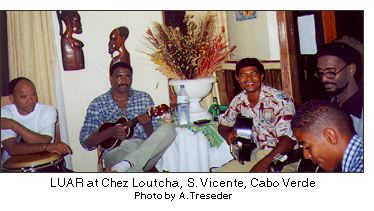 Other local musicians dropped by and sat in. A man at one of the tables borrowed the portable microphone and began serenading the women in the audience. Luar accompanied him flawlessly. Other local musicians dropped by and sat in. A man at one of the tables borrowed the portable microphone and began serenading the women in the audience. Luar accompanied him flawlessly.
The next evening, Teresa, whom I had met on the plane, arrived at Chez Loutcha with her sister Aldina and Aldina's daughter. I grabbed my coat (which I didn't need!), and we drove all over Mindelo doing errands. They took me to their home, where I met Aldina's other two children and her husband. Aldina's son Josias got out his guitar and, without any prompting from me, began to sing one of my favorite songs, a "Colaboi" from the neighboring island of Santo Antão. The whole family knew the words, and soon they were all singing, and dancing too, as Josias continued to play.
On Sunday, Loutcha and her staff trooped over to Calhau, on the opposite end of São Vicente, and prepared an afternoon of food and music. At noon, the musicians (from the group "Tradição da Terra") and hotel guests climbed into a flatbed truck for the bumpy ride over the desert to Calhau. I was the only woman on board, and they graciously let me sit in the cab with the driver. He drove slowly and deliberately over the rocky, unpaved roads.
When we arrived at Calhau, and the musicians began setting up, I learned that our driver was Zezinho, Tradição da Terra's talented violinist. Tola, the lead vocalist, sang his heart out, finding the emotion in every song. And Tanaia played the cavaquinho and guitar, and sang with a strong, soulful voice. The group performed for several hours, then strolled from table to table, singing Cabo Verde's unofficial anthem, "Sodade," written by Amandio Cabral.
When I was not exploring or listening to music, I watched a little television, including RTP-Africa, and the national Caboverdian station, which has news, features, and cultural programming. One day, I saw Kode' di Dona, one of my favorite Caboverdian musicians, performing his music live on an afternoon talk show.
· · ·
If you travel to Cabo Verde, be prepared for amenities that may be less than what you encounter in the U.S. For instance, Chez Loutcha does not have outgoing phone lines; although you can receive incoming phone calls, you will need to use a phone booth outside the hotel to make calls. Chez Loutcha and many other businesses in Cabo Verde cannot accept credit cards.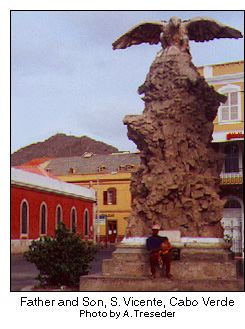 Some of the Mindelo street names are not clearly marked; and, try as I might, I could never find a detailed map of the city. Some of the Mindelo street names are not clearly marked; and, try as I might, I could never find a detailed map of the city.
But I found that for every minor inconvenience, something would happen that would remind me how blessed I was to be in Cabo Verde. For instance, as I was photographing a monument one day, a man nearby motioned for me to wait. He picked up his young son, and walked over to pose for me in front of the large bronze eagle symbolizing man's first flight across the South Atlantic, a flight that included Cabo Verde in its itinerary. I was so pleased that he wanted to be in my picture, and that he assumed (correctly) that I would want a photo of him and his child.
And just before I left Mindelo, Raslindo Duarte, from the Centro Nacional de Artesanato, came to Chez Loutcha and gave me a precious going-away present: a book about Caboverdian culture.
· · ·
There is a creation story that opens each broadcast day on Caboverdian national television: The screen is full of fire and explosions; and then the earth is formed. With more fire and noise, the continents break apart, and one sees the outlines of Africa. Finally, there is a volcanic explosion off the west coast of Africa, and, when the molten lava settles, a new necklace of golden islands is added to the world: Cabo Verde. The earth is now complete.
Now that I am back home, I cannot imagine my life being complete without having visited this beautiful place. Caboverdians live on small islands "in the middle of nowhere." There is very little rain, and food must be imported, along with almost everything else. Caboverdians have endured famines that have claimed many lives, and they are often forced to migrate in order to survive. Their mornas describe their longing to return.
But not all of their songs are sad. There are joyful songs that bounce, and others with a sly, intoxicating rhythm. These songs -- the coladeira, mazurka, and funana -- are also the music of the Cabo Verde islands.
Caboverdians know full well that most of the world has never heard of them. But they walk with justifiable pride on their own sweet land.
USEFUL INFORMATION:

The preparations necessary for a trip to Cabo Verde are easy if you plan ahead.
You must first obtain airplane tickets to and from Cabo Verde. (South African Airways [1-800-722-9675] flies from NYC to the island of Sal, site of the international airport, every Tuesday afternoon; one can return from Sal to NYC on any day. There are more frequent flights on the Lisbon-Sal route.) Tickets for intra-island flights on TACV can be purchased in the United States or in Cabo Verde. For information, reservations, and good advice, I relied on Celso at Neves Travel in New Bedford, 1-508-996-1332.
Next, you must obtain a visa from the Republic of Cabo Verde through its consulate in Boston. When you send your visa application, you will need to send your passport and return (from Cabo Verde) airplane ticket (I sent a photocopy of my ticket). The consulate can mail or fax the visa application and instructions. Their phone number is: 1-617-534-0096.
No inoculations are required, but several are advised. Check with your doctor, your local public health department, or the Travelers' Health website of the U.S. Government's Center for Disease Control. The toll-free phone 1-877-FYI-TRIP. The toll-free number for requesting faxed information is 1-888-232-3299.
Hotels:
- Hotel Morabeza, Santa Maria, Ilha do Sal; phone: 011-238-42-10-20; fax: 011-238-42-10-05.
Nightly rates (breakfast included) approximately $100 per night for double room; credit cards accepted. Music most nights; additional music in the village of Santa Maria.
- Chez Loutcha, Mindelo, São Vicente; phone: 011-238-32-16-36.
Nightly rates (breakfast included) approximately $20-$45; credit cards not accepted. Music on Wednesday, Friday, and Sunday; additional music at various venues in Mindelo.
· · ·
This article appeared in the April 15, 2001, and May 1, 2001 editions of the Portuguese Tribune, San Jose, California (USA). For subscription information, you may phone the Portuguese Tribune at (510) 785-8875.
· · ·
(To subscribe to Voz do Caboverdiano, the California Caboverdian newsletter, write to: CVSC Newsletter, Box 8178, Los Angeles, CA 90008; subscriptions are $20 per year.)
|
|





